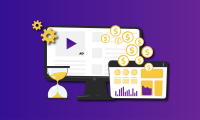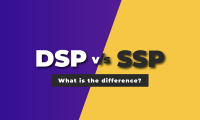Ultimate Checklist to Choose the Best Programmatic Platform in 2023
Programmatic advertising makes every second and penny count. The advent of programmatic platforms has taken the online advertising industry up a notch. According to the latest estimates, programmatically sold advertising was worth 418 billion U.S. dollars in 2021. This figure is expected to reach 725 billion by 2026.
Programmatic advertising has become a game-changer in the online advertising industry, with its potential for both increased spending and higher return on investments. The emergence of programmatic platforms has propelled the industry to new heights, making it an enticing opportunity for advertisers and publishers to capitalize on.
What are programmatic platforms?
The ad tech ecosystem has increasingly become AI-driven, with programmatic advertising platforms providing a powerful solution for automating the buying, selling, and management of online ad campaigns. By reducing the need for manual labor, programmatic advertising has emerged as a highly effective tool for businesses of all sizes and industries.
These platforms make it easier for publishers to manage their ad inventories and optimize their use, while also allowing advertisers to establish clear goals and objectives through systematic advertising. By leveraging these platforms, both parties can be confident in the accuracy and performance of their campaigns.
How do programmatic platforms work?
Programmatic advertising platforms operate on a bidding system, wherein advertisers bid on available ad inventories provided by publishers, with the highest bidder securing the ad placement. These platforms are designed to streamline the process of bidding, buying, and placing digital ads.
Through sophisticated algorithms and machine learning capabilities, programmatic platforms are able to analyze vast amounts of data in real-time, enabling advertisers to target highly specific audiences with personalized ads. This level of precision ensures that ads are served to the right people, in the right context, and at the right time, driving greater engagement and conversion rates.
What are the types of programmatic platforms?
More than types, these 4 ad platforms can be recognized as the ‘entities’ of programmatic advertising performing distinct operations.
- Supply-side Platform (SSP)
A supply-side platform (SSP), also known as a sell-side platform, is an ad tech platform that publishers use to manage their ad inventories. Publishers who have content platforms, such as websites and apps, can use SSPs to monetize their content and generate revenue through online advertising.
Publishers use SSPs to supply, distribute, and manage their available ad space. This enables them to sell their ad inventories in real-time, maximizing the bidding amount from advertisers. SSPs work in conjunction with ad exchanges and Demand Side Platforms to find potential advertisers for their publishers’ websites.
- Demand-side Platform (DSP)
Demand-side Platforms (DSP) and Supply-side Platforms often work together to facilitate programmatic advertising transactions. A DSP is an ad tech platform used by advertisers and agencies to purchase and manage their digital ad campaigns across multiple channels and ad exchanges. DSPs use data and algorithms to target specific audiences and optimize campaign performance.
A DSP helps advertisers find suitable ad inventories that match their requirements and niche, place bids on available ad space, and once approved, launch their ads. With DSPs, advertisers can run multiple ad campaigns in different formats and optimize their performance in real-time to achieve the best results.
- Ad exchanges
An ad exchange is a digital marketplace where advertisers, agencies, and demand-side platforms (DSPs) can buy and sell ad space. It serves as a mediator between the supply side, which comprises publishers and websites with available ad space, and the demand side, which consists of advertisers and their agencies.
Publishers or sites can bring their available ad spaces to an ad exchange, which aggregates them and makes them available for sale to advertisers. Advertisers can then bid on the available ad inventories using DSPs or through their own ad platforms. The highest bidder wins the ad space and their ad is displayed on the publisher’s website or app. Ad exchanges provide a streamlined and efficient way for advertisers to access a wide range of publishers and websites, and for publishers to monetize their content
- Ad networks
Ad networks are companies or platforms that aggregate publishers’ inventories and sell them to advertisers. By streamlining the process of buying and selling online advertising, these programmatic platforms provide a faster and more cost-effective method for planning, executing, and measuring the performance of campaigns. As a result, both advertisers and publishers can benefit from increased efficiency in the advertising process.
There are different types of ad networks, such as vertical ad networks that specialize in a particular industry or niche, horizontal ad networks that cover a broad range of industries and interests, or CPC ad networks that focus on the CPC advertising model. Some ad networks also specialize in certain ad formats, such as display ads, video ads, or native ads.
- Data Management Platform (DMP)
Data management platforms (DMPs) can be thought of as modern equivalents of data telephone directories, with more advanced and dynamic features. The success of programmatic advertising platforms is driven by the use of data, which enables advertisers, publishers, and agencies to deliver targeted advertising through ad platforms. A DMP is a platform that collects, organizes, stores, and activates data to be used in targeting digital ads. By leveraging DMPs, advertisers can effectively target the interests, behaviors, and demographic attributes of their audiences.
To do this, DMPs collect first-hand data from publishers or gather device or browser identifiers such as browser cookies, mobile identifiers, IP addresses, and device identifiers. This data is then used by demand-side platforms (DSPs) and supply-side platforms (SSPs) to better target their ad campaigns. By harnessing the power of data, DMPs enable advertisers to deliver more relevant ads to the right audiences, ultimately resulting in better engagement and ROI.
Factors to consider to choose the right programmatic platform
- Brand safety measures
Having a brand safety strategy is crucial for both advertisers and publishers to ensure that their ads are being displayed in a suitable environment. To achieve this goal, the Interactive Advertising Bureau (IAB) and the Media Rating Council (MRC) have established guidelines that advertisers and publishers must follow on their websites. It is essential to work with ad platforms that not only adhere to these regulations but also provide their own brand safety guidelines to advertisers, publishers, and agencies.
- Technology
Ad platforms utilize varying technologies, which serve as distinguishing factors when businesses choose an ad platform. The aim of advertisers and publishers should be to select an ad platform with technology that best aligns with their objectives.
To maximize their advertising results, advertisers and content creators should choose ad platforms that can analyze real-time data and use machine learning and AI to optimize campaigns. With AndBeyond.Media, a global SSP platform, publishers can get access to AI-driven technologies such as Yeild Maximizer and Health Score to get the highest CPMs and fill rates. Their team of Google Ad Manager experts provides end-to-end assistance from setting up the account to generating incremental revenue.
The buyers and sellers should choose ad platforms that integrate with other technologies, such as CRM, DMP, and CMS, as they can help streamline advertising efforts and improve targeting capabilities. Publishers should also consider if the platform offers advanced tracking ad performance and provide insights into analytics.
- Targeting options
Ad platforms offer a range of targeting options for publishers, advertisers, or agencies to choose from. These options can include geographical, demographic, retargeting, online behavior, or niche targeting, among others. Since contextual targeting is one of the top programmatic ad trends of 2023, it is important to choose an ad tech platform that provides it as one of the targeting options to yield the best results.
Therefore, it is recommended to compare different platforms or run test campaigns to determine which platform can offer the most benefits. The ability to customize audience targeting can greatly enhance the effectiveness and efficiency of an advertising campaign.
- Ad formats
Different programmatic platforms may offer a variety of innovative ad formats, but not every platform will support all of them. It is important for publishers, advertisers, and agencies to consider the ad formats they need and work with a programmatic platform that can meet those requirements.
Some programmatic platforms may specialize in specific ad formats such as video ads, native ads, audio ads, and in-app ads, while others may offer a broader range. Additionally, it may be beneficial to work with multiple ad platforms to access niche ad inventories or unique ad formats that are not available on a single platform.
- Technical and customer support
Programmatic advertising can be a complex landscape to navigate, even for those who are experienced in the field of ad tech. Businesses that choose to utilize programmatic ad platforms should seek out those that offer robust technical and customer support to ensure the success of their campaigns.
Technical support is essential because programmatic platforms often involve intricate technology, algorithms, and integrations with other platforms. Any technical difficulties that arise can be detrimental to a campaign’s performance, causing delays, inaccuracies, or even complete failure. Therefore, having access to 24*7 technical support can ensure that any issues are promptly addressed and resolved, minimizing the impact on the campaign’s effectiveness.
- Interface
The interface of an ad platform plays a crucial role in the user experience of advertisers and content creators. A user-friendly interface can greatly improve the efficiency of managing campaigns, analyzing data, and updating inventory. A platform with a complicated or confusing interface can lead to frustration, mistakes, and ultimately a waste of time and money.
It’s important to choose an ad platform that has an easy-to-use interface, where navigating through different sections of the platform, accessing data and analytics, and updating inventory can be done with ease. This can save time and reduce the chances of errors or mistakes, resulting in a more effective and successful advertising campaign.
- Tracking metrics
When choosing an ad platform for programmatic advertising, publishers, and advertisers must consider the metrics that are tracked and whether the platform offers guidance to improve them. Some of the metrics that programmatic platforms offer include ad impressions, clicks, click-through rate (CTR), viewability, and revenue. Businesses must ensure that the ad tech platforms they choose track these top 10 metrics to maximize revenue. The flexibility of programmatic platforms also allows for testing and experimentation to efficiently choose the right platform for a business.
Additionally, ad platforms serve as the gateway to earning more revenue while saving time and effort. Therefore, it is important to consider these metrics and testing options when selecting an ad platform to ensure that it aligns with the business goals and helps scale the business efficiently.
Programmatic advertising platforms represent the significant advancement of the digital landscape. With access to real-time data and the best ad tech platforms, publishers and advertisers can unlock incremental revenue while saving time and manual efforts. Therefore, it is crucial to conduct a thorough analysis when selecting a programmatic platform. This can enable advertisers and content creators to attain unparalleled levels of control, precision, and performance.




Leave a Reply